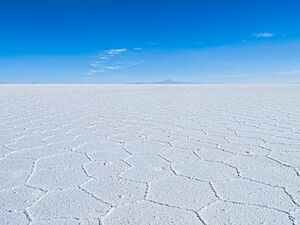Salt pan facts for kids
Imagine a vast, flat area that looks like it's covered in snow, but it's actually salt! These amazing places are called salt pans. They can be natural landscapes formed by nature or special areas built by people to collect salt. Salt pans are found all over the world, especially in dry, sunny places. They are important for both understanding Earth's geology and for producing the salt we use every day.
Contents
What Are Salt Pans?
Salt pans are large, flat areas where salt and other minerals collect. They are often found in deserts or coastal regions. The word "pan" here means a wide, shallow container, which describes their flat shape. These areas become salty because water evaporates, leaving behind dissolved minerals. There are different types of salt pans, each with its own unique story.
Natural Salt Pans: Earth's Salty Flats
Natural salt pans are also known as salt flats or playas. These are huge, flat stretches of land covered with a crust of salt and other minerals. They usually form in very dry places, like deserts. When rain falls in these areas, it collects in shallow basins. As the sun heats the water, it evaporates, meaning it turns into vapor and goes into the air. The salt and minerals that were dissolved in the water are left behind on the ground. Over many years, these layers build up, creating a thick, white, salty surface.
- Sabkha is an Arabic word for a type of coastal salt pan. These are often found along coastlines in arid regions. They are similar to inland salt flats but are influenced by seawater.
Making Salt: Evaporation Ponds
Another type of salt pan is a salt evaporation pond. These are not natural formations. Instead, people create them to produce salt. Imagine huge, shallow pools of water, often brightly colored, stretching for miles. These ponds are filled with saltwater, called brine, which is much saltier than regular ocean water. Workers pump brine into these ponds. Then, they let the sun and wind do the work. The water slowly evaporates, leaving behind pure salt crystals.
- The colors you sometimes see in these ponds, like pink, orange, or green, come from tiny microorganisms and algae that thrive in very salty water. It's a beautiful sight!
- This method is one of the oldest ways to produce salt and is still widely used today.
Modern Salt Production: Open-Pan Methods
While evaporation ponds use natural sunlight, open-pan salt making is a more industrial way to get salt. This method involves heating brine in large, open pans or special vacuum pans. Instead of waiting for the sun to evaporate the water, heat is applied to speed up the process.
- In vacuum pans, the pressure is lowered, which makes water boil at a lower temperature. This saves energy and allows for faster salt production.
- This method is often used to produce very pure salt for food or industrial uses. It gives producers more control over the size and quality of the salt crystals.
Importance
Salt pans are incredibly important for a number of reasons:
- They have been the primary source of salt for human consumption, food preservation, and industrial uses for millennia.
- Beyond sodium chloride, salt pans can be a source of other valuable minerals like gypsum, lithium, potassium, and magnesium, which are concentrated through the evaporation process.
- They are also popular tourist destinations, generating revenue for local communities.
- Salt pans are natural laboratories that help astrobiologists understand the potential for life on other planets (like Mars).
- Their sediment layers help scientitst learn more about past climatic and environmental conditions.
- The water levels and salinity of salt pans are highly sensitive to changes in precipitation and evaporation. Scientists study them as indicators of drought and long-term climate shifts.
- Salt pans support highly specialized and unique organisms like certain archaea, bacteria, and algae.
- They are also critical habitats for migratory and resident birds. Many shorebirds, including flamingos, avocets, and stilts, rely on salt pans for feeding on the rich invertebrate life and for nesting.
See also


